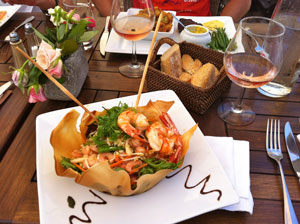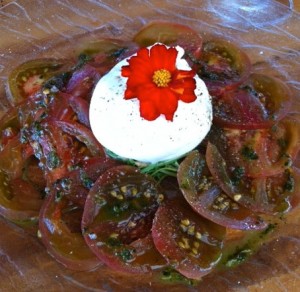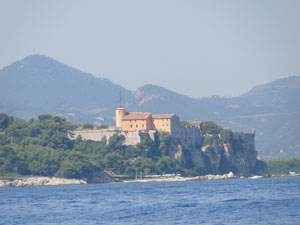Sunday afternoon started out innocently enough. Philippe, Lolo and I have been to church in Cannes – church, I say – and we are chatting with our good friend Walid after the service. We ask about a lunch spot.
L’Écrin, he recommends. Walid has lived in the Côte d’Azur forever and seems to know everyone. Indeed, he knows the owner of this intimate beach restaurant that is just a few minutes’ drive away. Walid rings to make a reservation for three. He insists on a good table.
Our journey takes us down Cannes’ storied seaside boulevard, La Croisette, where the Cannes Film Festival spills onto the streets in May in its most fashionable and frolicking manner. In today’s sultry heat, the route is lined with a handful of art stalls and people who move slowly. We merge right onto a peninsula that – all Anglo-friendly-like – is called Palm Beach. The soft sea air drifts into my open passenger window as Lolo, seated in her car seat directly behind me, begs for more stories about her antics as a baby.
Our seven-year old often asks about old memories when we’re in France. It was here in the Côte d’Azur that she ate her first ice cream, here that she took her first steps, and here that she lost her first tooth. (Unfortunately her firsts occurred in that very order.) Revisiting her earliest haunts resurrects these memories. Today’s story is a favourite – one that I already recited to her a few days ago – when, aged three, Lolo sat on the church’s front steps during the children’s talk. Asked what gifts her (earthly) father gave to her, she said quite simply, “Jewels.” The congregation tittered as they dreamt of sapphires and rubies – this is the Côte d’Azur, after all – but Lolo simply was describing the pink and purple plastic crystals that mounted in a glass jar at home for good behaviour. Twenty jewels meant a trip to the toy store.
Traffic comes to a standstill along the Palm Beach peninsula, and I’m suddenly aware of a woman standing at the curb. She’s striking with ebony skin, a pretty face and long, straight, black hair. Her strappy, full-length beach dress is filled quite amply at the top. And she’s staring right back at me through the open car window. I stop the story about the jewels.
The striking woman is suddenly talking to me from the curb. Does she need help? She’s saying something about – did she say something about her breast?
Yes, yes, I think she did. The busty woman is touching one of her ample firearms. She’s saying something – something in English, no less – about my husband touching her breast….
I become more aware of my husband sitting quietly next to me, trying to manage the traffic. And I become keenly aware of Lolo, my seven-year-old student of life who watches the performance from her box seat behind me.
“THAT IS INAPPROPRIATE!” I bark at the boob woman in a weird combination of good manners and sudden rage. I am Charlotte, all horrified and wide-eyed, in Sex in the City.
Fortunately, before my passenger window has closed fully, traffic starts to move. I’m riled up, sure I am, but I try to pretend nothing has happened and continue the sweet story involving a three-year-old girl and her plastic jewels.
The world Lolo is inheriting is far more cosmopolitan than my own was, aged seven in the US Midwest. Part of this inheritance is the world today, and yet I know this sun-drenched patch of the planet isn’t the Illinois cornfields. The French Riviera is where beauty salons advertise this – shall we say “cutting-edge” – treatment for your precious locks: diamond dust.
“Diamond dust!” Philippe said unbelievingly when we first heard the advert in the car the other day. My husband’s a bit of a rock guy. “Do you know what they really use diamond dust for? Cutting steel!”
But diamond dust sounds all glitz and glam, and that’s the sort of thing that’s revered here in the South of France. Diamond dust, and now Inappropriate Boob, help me understand that our parenting duties must work overtime here, searching out some sense of normality – whatever that is. It’s our third summer in a row in the sunny CDA, and before that we’ve come for long stretches over various parts of the year. If repetition brings familiarity, I fear familiarity will breed partial immunity to the Côte d’Azur’s oddities – both family-friendly and otherwise.
Somehow we’ve blown past Le Port Canto, the supposed location of Walid’s recommended restaurant, and we find ourselves in another parking lot on Cannes’ Palm Beach peninsula. We spot a sturdy man with a white beard and sun-wrinkled skin as he pulls some beach stuff from his car’s boot. His tropical shirt, red shorts and straw hat scream “local” – if he’s not Tommy Bahama in the flesh. Philippe slides down my window to ask directions.
Tommy goes through an animated and thorough explanation about how we get from here to there. He doesn’t leave out a corner or a cut-through. I’m watching him through the open window, pleased that I can understand about 80% of this friendly chit-chat.
Philippe thanks him. As we begin to pull away, Tommy calls out, “Enjoy it!” He says it exactly like that: “Enjoy it!”
“How did he know?” I ask Philippe, feeling all touristy. “Did you use your best French?”
“Yes – just like a Frenchman.”
I decide it’s my fault. I probably watched Tommy’s side of the conversation with a wide, American, post-orthodonture smile. Usually, though, it’s Philippe that gives us away, and he does it on purpose. I stay sagely silent in these sorts of conversations while he lathers up the froth on his Quebecois accent.

It’s amazing how much mileage this “we’re-old-cousins” language gets you in France. Just last week a quick phone call to Vegaluna, our habitual Sunday lunch spot on the beach in Cannes, determined that the place was all booked up. Booked up! And it was only mid-June, a full month before the usual summer onslaught!
So last Sunday, Philippe ambled into Vegaluna a couple hours before lunch. He worked up a good lather on his language. The restaurant’s host had lived on Saint-Martin, the French side, for 10 years with a bunch of Quebeckers. He had great memories. A table for six magically surfaced at the appointed hour.
This week it’s Walid’s beach restaurant, and it’s a find (once we finally find it). L’Écrin offers up such treats as this array of heirloom tomatoes with burratina cheese. We dine under a canopy of seaside umbrellas, a light breeze breathing over our shoulders and faces. Out in the bay sailboats zigzag through the waves with the 17th-century fortress on Île Sainte-Marguerite as our backdrop. Closer up, a couple topless bathers grace lounge chairs in the beach part of the restaurant, but as our table is conveniently elevated on the terrace – remember, this is the wife writing – all members of our party can focus on their food.

That said, a gorgeous, perfectly formed woman occupies the neighbouring table. She wears a lime green string bikini underneath an equally stringy white beach cover. Philippe has a good look as she walks by.
Another character parades through the tables with more regularity. Her face is nicely tanned but partly obscured by enormous, almost bug-like sunglasses. The rest of her is perfectly white. She wears a flowing white cover-up, under which we can make out a voluptuous figure and a white, one-piece bathing suit. She carries an enormous white bag full of things that are probably white. She conducts herself live a diva, though her cap is a little weird – snuggly fitting, almost like a piece of terry cloth that’s stitched together in the form of a ski cap. The second time Diva strolls her catwalk through the tables, I think she has forgotten something. The third time I wonder. The fourth and tenth times I realise what Diva has lost may be something more intrinsic.
Hours later – while l’Écrin’s food and ambiance were worthy of postcards, the pace of the service wasn’t – we amble back to our car. A white wig glows in the distance, on the other side of a grassy expanse. I guess that’d be in the wings, stage right. The wig is shoulder length and glossy and perfectly straight, and it’s sitting atop some black, sleeveless outfit.

Lolo is the most curious. Seven is the age of reason, so Philippe and I understand, and we can see it in our daughter’s behavior, her ability to remember the past, and her questions. But today is not the day to be reasonable.
The wig glides away from us. We realize it must belong to someone who’s perched on top of a passenger seat in a car that’s cruising along the main street of the Palm Beach peninsula. Yes of course, Lolo, White Wig should be wearing a seatbelt.
Philippe and I are careful not to attach a gender to White Wig. We want to say “she” but for some reason we both hold back. I cannot bear to explain the concept of trans-anything to my daughter who has a burgeoning sense of reason.
It takes a few moments to realize that we’ve happened on a parade of vintage cars. Philippe, a bit of a car buff himself, identifies a Ferrari Daytona from the 1960s or 70s, a Morgan that could be from the 40s, and a Jaguar from the 60s. (It’s an XK-E, he says. From the tone of his voice, I guess I’m supposed to be staggered.) The DeLorean catches our eyes with its winged doors spread wide open, skyward, as it cruises the street. Some of the cars’ occupants dress in the style of their vehicle’s vintage, such as the hippies in the late-60s Mustang who sport paisley shirts and full-on bellbottoms.
Once we’re outside Cannes’ limits, we’re finally home free, I think. We’re heading back to our far more normal, seaside town of Antibes for some family time. Except for the fact that Antibes is attached to Juan-les-Pins, which since its heydays in the 1920s, has always been a bit of a rabble-rouser.
There, strolling the sidewalk of this beach road, is Tarzan. It is his moment in the Côte d’Azur’s ever-shining spotlight. He saunters in our direction, side-by-side with Jane, who looks pretty normal if even a bit glamourous. (When I mention Jane to Philippe afterward, he will confess, “I never had a chance to look at her.” Which is really saying something.)
But Tarzan himself is magnificent. His long hair is pulled back tightly from his face, making it look like he has a cropped Mohawk on top, chased by a ponytail of braids dangling (or swinging rope-vine style) to the small of his back. His body is perfectly muscled and his skin gloriously bronzed and frequently tattooed. And we, the innocent passersby, have plenty of occasion to count his bulging muscles and fine tattoos because all Tarzan wears is a neutrally coloured, skin-tight pair of shorts – something between a pair of spandex short-shorts and a woman’s monokini.
Lolo hardly notices Tarzan. For all she knows, he could’ve been coming from someone’s birthday party. And me, well, I hardly give him all the attention he is worth. Somehow we are adapting to this theatre of the Côte d’Azur. Blatant recognition of this idea makes me worry anew about the world Lolo sees – and her nascent sense of normality and reason.
To amp up my anxieties (as mothers do from time to time), I now worry about the upcoming arrival of Toronto friends with their three intelligent, curious and hyper-aware children in tow – all aged six and seven.
What will these bright sparks glean from the sidewalks of the Riviera during their first trip overseas? What will the parents think of this hive of indulgence where we choose to socialize our own intelligent, curious and normally hyper-aware daughter, aged seven, for the whole of every summer during her tender childhood? The same girl whose socialization we nurture much more carefully in Canada for the bulk of the year – the girl who’s a classmate, friend, team member, travel partner and confidant of their own children?
And which – I fear even contemplating this question – which of Inappropriate Boob, Diva, White Wig and Tarzan’s co-leads will jump on the Côte d’Azur’s revolving stage and sing their arias to welcome these good Canadian guests to town?

